Self-propelled artillery 15 cm sIG 33 auf Fahrgestell Panzerkampfwagen II (Sf) / Sturmpanzer II (Germany)
Already at the end of 1940, it was decided to continue the development of self-propelled artillery systems. In the near future it was planned to create and put into service a new combat vehicle with an 150-mm gun. As a basis for the new machine, it was proposed to use the chassis, created on the basis of the existing technology. The light tank Panzerkampfwagen I already showed insufficiently high performance, which is why it was decided to build a promising self-propelled gun based on the newer Pz.Kpfw.II. The troops had a significant number of such armored vehicles, which made it possible to simplify the construction and operation of the new technology.
According to the experience of the previous project, it was decided to seriously rework the design of the base tank for the installation of a new gun. Relatively simple alteration, similar to that used during the creation of the previous ACS, was considered inexpedient. Due to the simplified installation system of the gun and the armored felling, the 15 cm sIG 33 Sfl. auf Pz.Kpfw.I Ausf.B had too much height, which facilitated its detection by the enemy, and also led to unacceptably high alignment and the risk of coup on the slopes. To eliminate these shortcomings, a significant redesign of the base machine design was required.
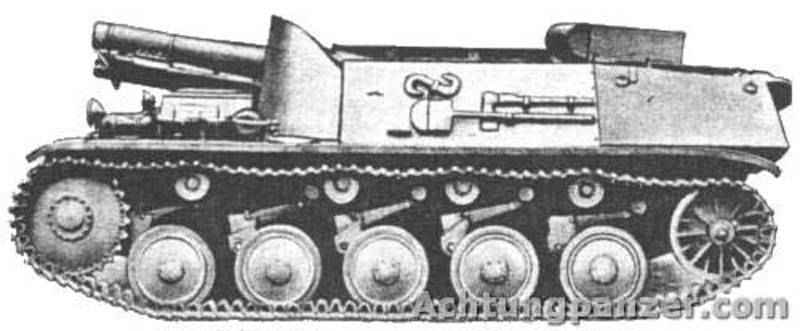
The first prototype of ACS Sturmpanzer II based on a five-rolled chassis. Photo by Achtungpanzer.com
In accordance with the German designation system for armored vehicles, the new project is called 15 cm sIG 33 auf Fahrgestell Panzerkampfwagen II (Sf), which noted the types of weapons used and the base chassis. The alternative designation Sturmpanzer II was also used. In some modern sources it is mentioned that the new project "inherited" the nickname of the previous one - Bison.
To install the required tool and solve the basic layout tasks, the authors of the new project had to seriously rework the hull of the basic light tank. The tank was supposed to be deprived of a tower and a box of towers. In addition, it was proposed to change the design of the upper part of the body, while retaining some of its units. All these changes allowed freeing up enough space for installing a large gun and placing its calculation, as well as reducing the dimensions of the ACS to acceptable values.
The hull retained a frontal part consisting of several armor plates 30 mm thick. The lower front plates remained in their places, while the building of the department of control was divided into two parts. The left unit of the divided part of the body was supposed to perform the functions of a driver's cabin. Behind the two thinning of the front of the hull was a superstructure of a new design. Its frontal part consisted of several 30-mm sheets, angled to each other and inclined inward. The logs had a thickness of 15 mm and were also mounted with a blockage. For more convenience, hitting the inside of the fighting compartment of the wheelhouse was different from the front plates of a smaller height. The aft parts of the hull and deckhouse were protected by 15-mm armor.
Recycling the hull design did not lead to a dramatic change in the layout of the machine. In front of the hull, the transmission and control units were still located. In the center there was a fighting compartment with weapons and crew jobs, and the food was allocated for the placement of the engine, radiator, fuel tanks, etc.
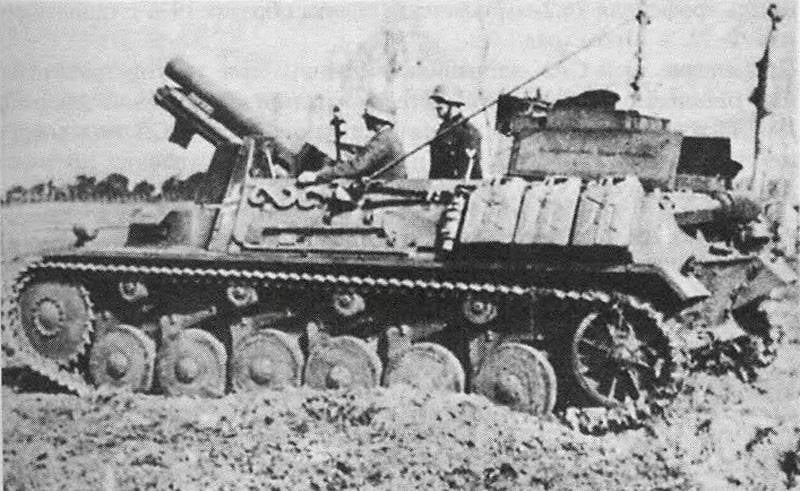
Series machine with an extended roller. Photo of Chamberlain P., Doyle H. "Complete reference book of German tanks and self-propelled guns of the Second World War"
The ACS was supposed to be equipped with a Maybach HL 62TR carburetor engine with 140 horsepower. There is also information about the use of 150-strong engines Büssing-NAG L8V, however, confirmation of the mass use of such engines are missing. Transmission self-propelled unchanged borrowed from the base light tank. It included the main friction clutch dry friction, six-speed gearbox, as well as a planetary rotation mechanism, combined with brakes and final drives.
The chassis of the base light tank was retained, and in the course of refining the project it underwent some changes. Thus, the undercarriage of the first prototype was built on the basis of five track rollers with an individual spring suspension on each side, and the improved version had a six-track chassis. Driving wheels were placed in the front of the hull, guides - in the stern. To maintain the upper branch of the caterpillar there were several rollers of small diameter.
In front of the cabin, it was necessary to mount a gun mount. In the new project 15 cm sIG 33 auf Fahrgestell Pz.Kpfw.II (Sf) decided to abandon the use of the existing carriage with a wheel course. The gun and its mounting systems with anti-recoil devices should now be fixed to the base chassis housing. Also, the gun was deprived of its own shield - the cover of the calculation was now placed on the front sheets of the deckhouse. This allowed to a certain extent to simplify the design of ACS, as well as to increase the level of protection.
The main weapon of the self-propelled gun was the heavy 15 cm sIG 33 L / 12 field gun. This 150-mm gun with a barrel length 12 calibers intended to fire various objects, primarily fortifications of the enemy. In addition, the weapon had the highest efficiency when used against enemy manpower, and could also destroy armored vehicles of various classes. In ammunition guns included several types of ammunition: high-explosive fragmentation, smoke and high-explosive above-caliber. Over time, a cumulative projectile was also developed. Used ammunition separate loading with a variable charge.
The sIG 33 was equipped with a horizontally sliding gate and hydropneumatic anti-recoil devices. Experienced calculation could do up to 3-4 shots per minute. The installation mechanisms made it possible to direct the gun in a horizontal plane within a sector of width 20 °. Elevation angles varied from -3 ° to + 73 °. By changing the elevation angles and the charge, it was possible to shoot at a distance of 4,7 km. For aiming the gun was completed with a telescopic sight Rblf36, previously used as part of the towed system.
The dimensions of the fighting compartment made it possible to transport ammunition in 30 separate loading shots. In view of the intended role on the battlefield, most of the ammunition should have been high-explosive fragmentation projectiles. The need to use a large number of smoke projectiles was absent, and cumulative ammunition appeared relatively late and was also not considered as the basis of ammunition.
As an additional weapon for self-defense, the crew of the vehicle could use the MG 7,92 34-mm machine gun. it weapon with ammunition needed to be stored in the styling of the fighting compartment. Systems for installation, providing a constant combat readiness of the machine gun, were not provided. Also, the crew had to have a personal small arms.
The crew of SAU 15 cm sIG 33 auf Fahrgestell Panzerkampfwagen II (Sf) was to consist of four people. In front of the hull there was a driver who had to get into his place through the hatch in the armored wheelhouse. To monitor the expensive driver had to use the viewing devices in the front and side sheets of the cabin. The commander, gunner and loader were placed in the open-top combat compartment. Their task was to search for targets, pointing guns and shooting. In addition, the commander was responsible for the operation of the radio station Fug Spr I.
Due to the preservation of the base parts of the tank chassis, the prospective self-propelled guns should not seriously differ from the Pz.Kpfw.II Ausf.B in their dimensions. The length of the vehicle was 4,8 m, width - 2,23 m, height - about 2 m. The combat weight also remained at the level of the parameters of the serial tank. All these features of the new project allowed us to rely on the preservation of the general characteristics of mobility. The maximum speed on the highway was to reach 40 km / h, the cruising range - up to 180-190 km.
The development of the Sturmpanzer II project was completed at the very beginning of 1941 of the year, after which the assembly of the first prototype started. As the basis for the prototype took the serial light tank Pz.Kpfw.II Ausf.B. From the tank cut off the upper part of the body, instead of which they installed a new wheelhouse. In the updated fighting compartment mounted 150-mm gun required model and all the necessary additional equipment.
In February, the 1941 of the year, the prototype of the new ACS went to the ground tests. The checks revealed the project’s shortcomings in their current form, as well as defining a list of necessary improvements. So, it was found that the existing chassis is not very durable, which is why it cannot be a full-fledged carrier of the sIG 33 gun. In addition, testers noted the unacceptable closeness of the fighting compartment associated with the size of the hull and the dimensions of the breech of the gun. In the current state, the new self-propelled gun could not be ordered by the troops. The project was sent for revision.
By the summer of 41, the authors of the project presented a new version of the self-propelled gun. To improve the working conditions of the crew and strengthen the structure, it was decided to change the dimensions of the hull. The length of the vehicle was increased by 600 mm, and the width - by 300 mm, which made it possible to increase the available volumes for the crew. Also in the direction of simplification was changed the design of the cabin. Increasing the length required to add to the chassis of the sixth pair of road wheels, similar to the available five. This led to a slight increase in the undercarriage, which made it possible to compensate for a significant increase in recoil. The updated machine had a length of 5,41 m, a width of 2,6 m and a height of 1,9 m. The combat mass had grown to 11,2 t.
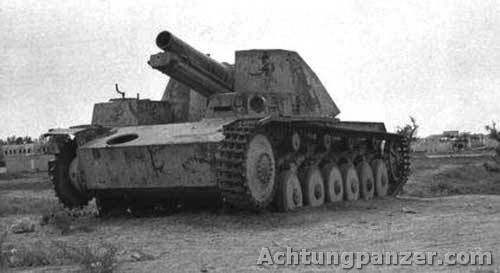
One of the self-propelled guns, abandoned by the crew. Photo by Achtungpanzer.com
The second prototype self-propelled gun 15 cm sIG 33 auf Fahrgestell Pz.Kpfw.II (Sf) on the extended and extended chassis was built in July 1941 year. Tests showed that the design was correct and allowed to solve the tasks. Increasing the weight of the machine had almost no effect on mobility. The maximum speed remained at the same level, although the power reserve was slightly reduced. Due to the lack of processing weapons, the firepower of the modernized self-propelled gun remained at the same high level.
According to the results of the tests, it was decided to adopt the new ACS for the armament and establish its mass production. The order for the assembly of mass-produced cars was received by Alkett, which was previously engaged in the production of self-propelled guns Sturmpanzer I. In the autumn of 1941, the contractor started the production of new equipment and produced the first machines. By this time, the Alkett plant was loaded with other orders, because of which the massive construction of new self-propelled guns was difficult. Until the end of 1941, only 12 self-propelled guns were built, after which they decided to stop their production, so that it no longer interfered with the execution of more important orders.
Serial self-propelled guns of the new type were reduced to the 707 and 708 companies of heavy infantry guns. At the beginning of 1942, both companies were sent to Africa to support infantry in battles in Libya and Tunisia. Machines of the new type were constantly used in various sectors of the front, where they fought with infantry, equipment and fortifications of the enemy. According to various sources, some of the 15 cm sIG 33 auf Fahrgestell Panzerkampfwagen II (Sf) self-propelled guns were destroyed by May 1943. There is also information about the use of the remaining samples of this technology until the very end of the fighting in Africa, after which they were evacuated to Europe.
Some sources mention the sending of two ACS Sturmpanzer II on the Eastern Front. However, the details of the operation of this technology in the war with the Soviet Union are not available.
At the end of 1941, only 12 ACS 15 cm sIG 33 auf Fahrgestell Pz.Kpfw.II (Sf) with 150-mm guns was built, which was not enough to fully re-equip the army. Nevertheless, the emergence of this technique allowed us to strengthen some of the existing units with powerful guns on a mobile chassis. Operation of such self-propelled guns lasted for some time, after which it was destroyed or written off after the development of the resource. A dozen vehicles had some influence on the course of the battles on various sectors of the front in North Africa, but could not save the German troops from defeat.
According to various sources, until the end of the Second World War, all Sturmpanzer II built were destroyed or dismantled. However, at the time of the termination of the operation of such machines, the German army had a significant number of new self-propelled guns sIG 33. The most successful samples of such technology, unlike 15 cm sIG 33 auf Fahrgestell Panzerkampfwagen II (Sf), were built in the amount of several tens and hundreds of pieces.
Based on:
http://aviarmor.net/
http://achtungpanzer.com/
http://all-tanks.ru/
Chamberlain P., Doyle H. Complete reference book of German tanks and self-propelled guns of the Second World War. - M .: AST: Astrel, 2008.
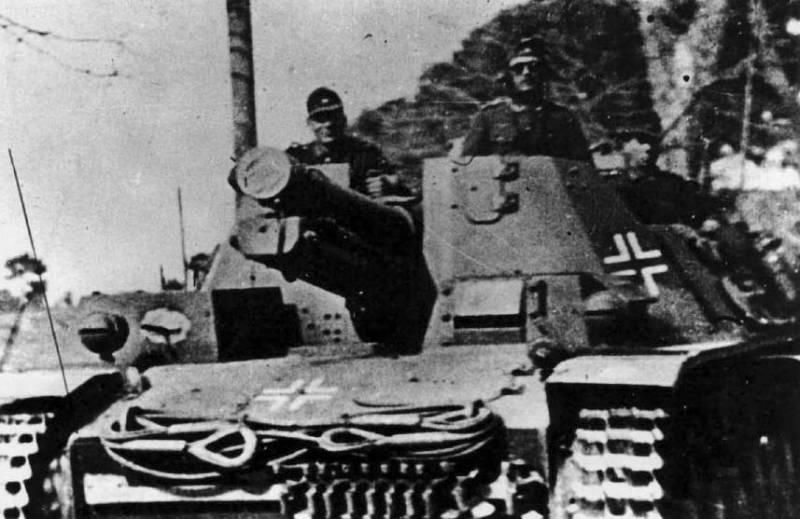
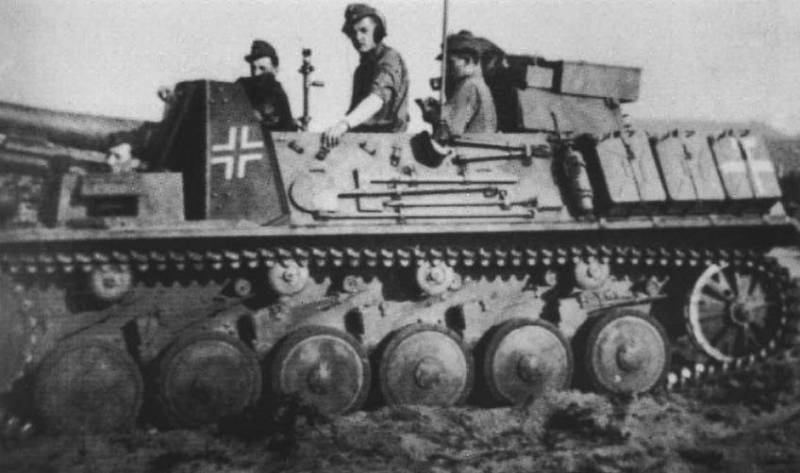
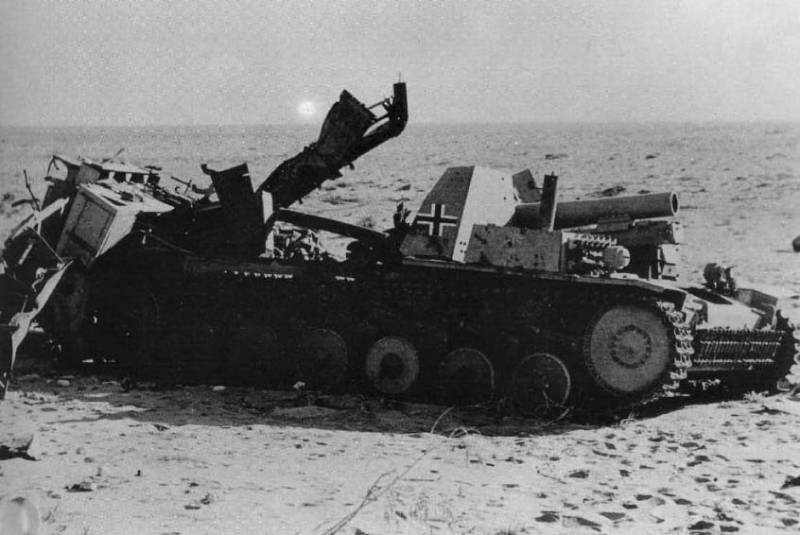
Information